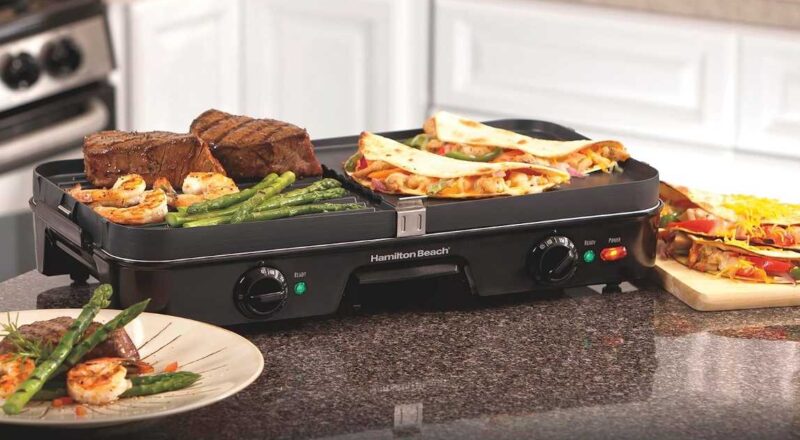In the dynamic world of culinary arts, the reversible griddle stands out as a versatile tool that every kitchen professional should understand. The key to maximizing its utility often lies in understanding the intricacies of griddle thickness. This reversible griddle thickness guide aims to shed light on this essential aspect, helping both amateur cooks and seasoned chefs make informed decisions.
When it comes to griddles, thickness plays a crucial role in determining cooking efficiency and food quality. A well-chosen griddle can elevate your cooking experience, making it crucial to understand the nuances of thickness options available in the market. In this article, we delve into the specifics of griddle thickness, ensuring you have all the necessary information to select the perfect griddle for your kitchen.

What is a Reversible Griddle?
A reversible griddle is a cooking surface that features two sides, each designed for different cooking methods. Typically, one side is flat, ideal for pancakes, eggs, and sandwiches, while the other has ridges, perfect for grilling meats and vegetables. This dual functionality makes it a staple in many kitchens.
Importance of Griddle Thickness
Thickness is a critical factor that influences a griddle’s heat retention and distribution. A thicker griddle generally retains heat better, providing consistent cooking temperatures. This is particularly important for professional kitchens where precision is key. Understanding the right thickness for your needs can significantly impact your cooking results.
Heat Distribution and Retention
Thicker griddles tend to distribute heat more evenly, preventing hot spots that can lead to uneven cooking. This uniformity is crucial for achieving the perfect sear on meats or the ideal texture for pancakes. Consistent heat retention also means less energy is required to maintain cooking temperatures, making thicker griddles more energy-efficient.
Durability and Longevity
Investing in a thicker griddle often means longer-lasting performance. Thicker materials are less prone to warping and damage over time, ensuring that your griddle remains a reliable kitchen partner for years. This durability makes it a worthwhile investment for both home cooks and professional chefs.
Choosing the Right Thickness
When selecting a reversible griddle, consider your primary cooking needs. If you frequently cook delicate foods or require precise temperature control, a thicker griddle may be beneficial. However, if portability and quick heating are priorities, a thinner griddle might be more suitable.
Common Thickness Options
Griddles typically range from 1/4 inch to 1 inch in thickness. Each thickness offers different advantages:
- 1/4 inch: Quick to heat, lightweight, ideal for camping.
- 1/2 inch: Balanced heat retention and portability, suitable for most home kitchens.
- 1 inch: Excellent heat retention, best for professional settings where consistent cooking is crucial.
Considerations for Professional Kitchens
In professional kitchens, the choice of griddle thickness can affect workflow efficiency and food quality. Thicker griddles are often preferred for their ability to maintain stable temperatures during high-volume cooking. This stability can reduce cooking times and improve dish consistency, critical factors in professional food preparation.
Maintaining Your Reversible Griddle
Proper maintenance is vital to prolonging the life of your griddle. Regular cleaning and seasoning can prevent rust and ensure optimal cooking performance. For detailed maintenance tips, you can refer to this Reversible Griddle Maintenance Tips.
Cleaning and Care
After each use, clean your griddle with warm water and a mild detergent. Avoid abrasive cleaners that can damage the surface. For stubborn residues, a mixture of baking soda and water can be effective. Learn more about griddle care in the Reversible Griddle Care Dos and Don’ts.
Seasoning for Longevity
Regular seasoning with oil can protect your griddle from moisture and enhance its non-stick properties. This process involves applying a thin layer of oil to the surface and heating it, creating a protective barrier that improves with each use.
Enhancing Your Cooking Experience
Understanding the nuances of griddle thickness can significantly enhance your cooking experience. By selecting the right thickness for your needs and maintaining it properly, you can enjoy consistent, high-quality results for years.
Adapting to Different Cooking Styles
A reversible griddle’s versatility allows it to adapt to various cooking styles, from grilling to frying. By choosing the appropriate thickness, you can optimize your griddle for specific culinary techniques, whether you’re searing a steak or crafting a delicate crepe.
Pairing with Other Kitchen Tools
Pairing your griddle with complementary kitchen tools can further enhance its utility. For example, using a heat-resistant spatula can prevent surface damage, while a lid can trap heat and moisture, perfect for steaming dishes.
Conclusion: The Importance of Thickness
In conclusion, the thickness of a reversible griddle is a pivotal factor that affects its performance and longevity. By understanding and selecting the right thickness for your cooking needs, you can unlock the full potential of this versatile kitchen tool.
For more insights into griddle cooking, explore the Griddles 101 Guide for expert tips and recipes that can take your culinary skills to the next level.

FAQs
What is the best thickness for a reversible griddle?
The ideal thickness depends on your cooking needs. For home use, 1/2 inch is versatile, while professional settings may benefit from 1 inch for better heat retention.
How do I maintain my griddle’s surface?
Regular cleaning and seasoning are key. After each use, wash with warm water and mild detergent, and season with oil to maintain its non-stick properties.
Can a thicker griddle improve my cooking?
Yes, a thicker griddle offers better heat retention and distribution, leading to more consistent cooking results and improved energy efficiency.
This article contains affiliate links. We may earn a commission at no extra cost to you.

